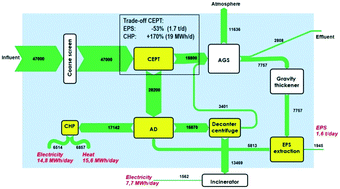Exploring resource recovery potentials for the aerobic granular sludge process by mass and energy balances – energy, biopolymer and phosphorous recovery from municipal wastewater†
Abstract
Municipal wastewater cannot any longer be perceived as a waste stream because it contains water, energy, fertilizer and other products that can be recovered with innovative technologies in so called ‘water resource factories’. Therefore a paradigm shift has been proclaimed to design water resource factories in the future that feed into a circular economy. The rapid development of new resource recovery technologies requires a solid analysis prior to their integration into treatment processes to understand more about their potential to contribute to more circular urban water management practices. Mass and energy balances are an excellent method to model resource recovery potentials of innovative processes at an early design stage because they allow quantifying recoverable resources as well as trade-offs between possible recovery technology choices. We modelled a real wastewater treatment plant which uses aerobic granular sludge treatment and is currently operated with no on-site resource recovery. Then, 5 different possible process designs that would recover chemical oxygen demand (COD) as energy and/or extracellular polymeric substances (EPS), and phosphorous (P) as struvite have been modelled. The integration of anaerobic digestion for subsequent electricity and heat generation from methane provides the possibility to recover on-site a rather small fraction of influent-COD as energy. But if this is combined with chemically enhanced primary treatment (CEPT), almost one third of the influent-COD may be recovered. Simultaneous energy and EPS recovery may lead to trade-offs as CEPT integration for maximum energy recovery may halve the EPS recovery potential but would increase the overall influent-COD recovery rate. Struvite fertilizer recovery integration may only recover a small fraction of influent-P and is therefore questionable when other P recovery options are possible that aim for higher recovery rates. The fertilizer recovery potential may be significantly decreased by EPS recovery since the latter contain P. This study helps to understand how aerobic granular sludge based treatment processes can be designed as water resource factories. Mass and energy balances can be conducted at a very early process design stage and results may be used to identify promising process designs for subsequent more in depth techno-economic or environmental impact assessments.



 Please wait while we load your content...
Please wait while we load your content...